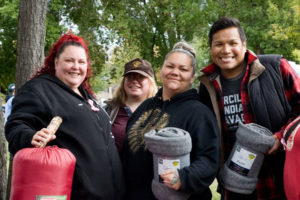By MARGIE O’LOUGHLIN
Jase Roe and his partner recently bought a house near Minnehaha Falls. In between packing and unpacking, and studying to become an addiction counselor at MCTC, Roe is spending many hours each week at The Wall of Forgotten Natives (also known as the Franklin Hiawatha Encampment). A former heroin and methamphetamine addict, Roe understands the complexities of addiction from both sides.
“There’s a stigma attached to being Native American that can break you,” Roe said. “I’m a member of the Northern Cheyenne Tribe of Montana. I was adopted by one of my aunts as a baby and raised in Eagan. Growing up in a white suburban community, I was bullied a lot. I turned to drugs early and lost 25 years of my life to addiction. I’m 42 now, and sober for almost six years. My struggle with addiction helps me to understand what some of the people in the encampment are dealing with.”
 Photo right: Jase Roe (pictured right) and friends at a blanket and clothing drive event. (Photo by Margie O’Loughlin)
Photo right: Jase Roe (pictured right) and friends at a blanket and clothing drive event. (Photo by Margie O’Loughlin)
Roe spends his time at The Wall learning names and faces, and directing campers to available services. Last week, he logged two days signing people up for medical insurance and flu shots.
The Franklin Hiawatha Encampment held as many as 300 campers at its peak this summer. Roe estimates that number is closer to 200 now, about 80% of whom are Native. He noted, “The population has grown more challenging. There are hardly any kids around anymore, which is good. Most of the families have been taken in by local churches or have found temporary shelter with help from the Metropolitan Urban Indian Directors (MUID). There is still a sense of community in the encampment, but the number of drug users has grown considerably. In my opinion, many people there are in survival mode.”
The City of Minneapolis and its agency partners had hoped to transition residents of the encampment to temporary housing by Sept. 30, but that date has come and gone. After three emotional city council meetings, a decision was made to develop properties owned by the Red Lake Band of Chippewa Indians on the 2100 block of Cedar Ave. S. and the 1800 block of 22nd St. E. This is a short-term option, but all parties agreed it was the best of the possible, imperfect solutions.
Buildings on the sites have to be demolished, and some environmental remediation done before FEMA style trailers, water, and sanitary sewer can be brought in. Roe said, “I’m apprehensive about how long all that will take, and about who will actually be housed. There are many more people in the encampment than there are anticipated beds.”
For those outside the Native American community, it can be hard to understand how this situation has gotten so bad. A statement issued by the Metropolitan Urban Indian Directors offered a thoughtful explanation: “Minneapolis is built on Dakota land, and has long been home to a significant number of Native Americans. Generations of genocide and forced assimilation have made the 21st century very challenging for Native people, who make up a disproportionate number of the homeless in Minneapolis. Causes of homelessness are related to addiction, mental illness, domestic violence, joblessness, economics, and many other causes.
Minnesota’s opioid addiction crisis continues to hit the Native American population especially hard.”
In a situation packed with unknowns, one thing is certain—winter is coming. A very successful blanket and clothing drive has just ended. Anyone wishing to make a monetary donation toward meals can send a check to the Native American Community Development Institute (attention Two Spirit Society: encampment meals). Their mailing address is 1414 E. Franklin Ave., Suite #1, Minneapolis 55404.
As Roe settles into his new home, he is well aware that this is the second time he has lived in this neighborhood. The first was several years ago when his home was a mattress in the basement of a drug house near Lake Nokomis. “My life was a total mess then,” he said. “I realized I was either going to die soon, or go to prison. I had lost everything. Even my teeth had fallen out because of my meth addiction. If I smiled, I always covered my mouth with my hand. I have a new life now, thanks to the Minnesota Two Spirit Society, Out and Sober Minnesota, and my own motivation. I can leave a legacy of hope for my nieces and nephews now because I was given another chance.”
Comments
No comments on this item Please log in to comment by clicking here